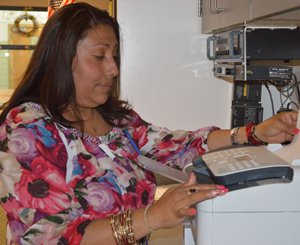Lydia Hernandez took the day off from volunteering at the elementary school to prepare a big meal for visitors from the district’s human-centered design team. Around the table, team members interviewed her for 90 minutes about her husband, who was at work, her background and her education. They asked her about dreams for her children, Kevin, an eighth-grader and Kaylee, a fourth-grader.
The team added Hernandez’s comments, along with those from 19 other district families, to data they are using to reform the district according to the needs of students using the human-centered design process, an approach to problem solving that incorporates the wants and needs of end users of a product or service in every stage. It starts and ends with the beneficiary, in this case Godfrey-Lee students.
“It felt good because they chose my family,” said Hernandez, a committed volunteer at Kaylee’s school. “I was able to talk to them about my story, my family and my kids… The opinion of the parents is important.”
Interviewing families was part of the initial year of the two-year process, under way to improve education in the small, mostly Hispanic, low-income district. The team – nine teachers, five administrators, a support staff member, a Board of Education member, a leadership coach and two design consultants – also spent 60 hours at 22 work sessions exploring information to determine true needs of students.
The process is funded by a $250,000 Steelcase Foundation grant, which is covering guidance by representatives of New North Center, a Holland-based nonprofit hybrid education and business organization. It includes a leadership and accountability coach, stipends for session participation and other tasks.
Of the 20 families, teams interviewed parents of students in the district, parents of graduates, a Schools of Choice parent, and those who are very involved and uninvolved in the schools. Each group interviewed three Hispanic, one black and one white family, mirroring the district’s demographics. They also interviewed an Iraqi family. Plans are to continue interviewing other district stakeholders, such as business people and alumni.

What’s the End Goal?
“Why we are doing this is because we don’t have an education system that helps kids realize their dreams, their vision and their goals for the future,” said Superintendent David Britten.
The team aims to work toward new ideas, instruction philosophies and programs that better suit students’ individual needs, said Britten, who is an advocate for play-based learning in early childhood education and classrooms where all students can take different pathways to develop their own interests.
Currently, schools are run with pre-set expectations that aren’t working for many students, he said. “We are telling them, ‘This is your goal. Your goal is to go to college. This is the path to getting there because it was a path created based on the average student, and everyone is expected to take that same path.'”
The team has studied broad topics: school-parent communication and relationships, creating a culture of acceptance and belonging, socialization in learning, and student choice.
Meetings have resulted in interconnected diagrams under headings like Relevance, Dynamic Learning, Community, Soft Skills and Basic Needs. Hundreds of ideas gathered from district stakeholders are written on Post-It notes with messages such as “Students need to create meaning,” “Students need to do to know” and “Students need today’s interests to be the foundation ofnew learning.”
Human-design team member Jason Cochran, a teacher at the alternative high school, East Lee, said ideas at the secondary level have included putting students in charge of what goes on at school, making it more of a democratic process in which students have input. Also, he said, that a more flexible schedule may benefit teenagers.
“A big part of it is focusing on what the kids themselves are interested in,” he said, noting that it’s often a battle convincing students what they need to learn.
He asked a few of his own students how they could learn better. “One was very outdoorsy and really into nature and animals,” Cochran said. “Immediately, he said, ‘I wish we could have school outside and learn about things like that. Instead I have to sit at a desk eight hours a day.’ That doesn’t work for him.”
Getting Rid of The Average
Britten has often said that he envisions a district without clocks, calendars or grade levels and no expectations based on averages. It’s the opposite of the current system, which he calls outdated and ineffective.
“The system itself is a structure based on the average,” he said. “It’s been designed that way purposely, because we have this mythical idea there is an average kid out there, which no one can ever identify because an average kid does not exist.”
Yet, in using a mathematical average with 20 percent at the top and 20 percent at the bottom, somewhere in the middle lies what is currently deemed the “average” child, on which time constraints and curriculum is based.
But peek into a Godfrey-Lee classroom and that child isn’t there. “We have kids all over the place because of poverty, because they’ve moved here from low-performing schools or different countries so they have language barriers,” Britten said. “We are still expected to move them all one full year of academic growth even if they aren’t ready for it.
“Our whole process this year has been to identify that as the problem and to gain empathy with all the stakeholders in this process to see it from their points of view.”
CONNECT









